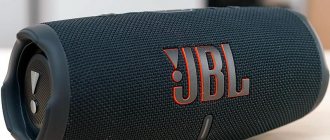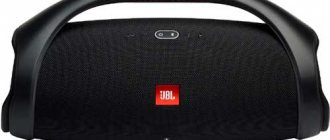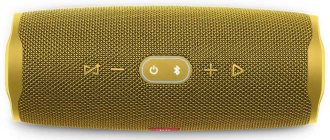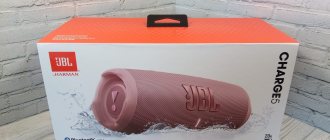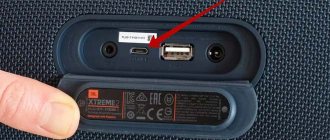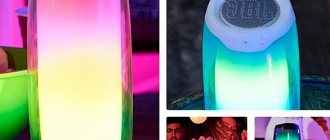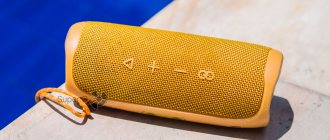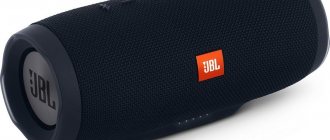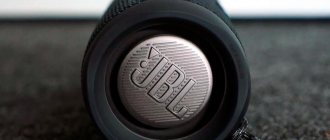The acoustics manufacturer JBL is familiar to most for its headphones and speakers for home use. The increased popularity of wearable electronics has prompted the company to create wireless speaker systems designed for outdoor enthusiasts. One of the lines was called Charge, and its distinctive feature was high-capacity batteries, which make it possible, in addition to the long operation of the device itself, to work as a power bank. This review is dedicated to the third generation of the line of wireless speakers – the Charge 3 model.
Equipment
The speaker is packaged in a standard Charge bright box made of thick, high-quality cardboard. In addition to colorful images of the speaker itself, pictograms were placed on the packaging to remind the buyer about the main capabilities of the speaker. One of the sides is occupied by brief instructions informing about setting up the joint operation of several Charge 3 speakers from one sound source.
Portable Bluetooth speaker JBL Charge 3
Charge 3 from JBL became a sales hit on the wireless speaker market in 2015-2016 and still does not lose its relevance. It did not look worse compared to new models of Bluetooth speakers, but it decreased in price. Today, this speaker system has the necessary features of a proper wireless audio system.
It is not surprising that the American company JBL achieved success in the mid-1990s. The manufacturer has over 70 years of experience in producing audio systems and related Bluetooth accessories. Thanks to Bluetooth technology, the company has taken a step further and opened the world of wireless acoustics for itself and millions of customers. JBL Charge 3 with the Bluetooth system has a recognizable design, bright colors, loud sound, and durability.
The main advantages of the Charge 3 are its components. Despite the dimensions, many technical parts and useful technologies fit inside. The model contains:
- speakerphone;
- two passive radiators, powerful speaker;
- large battery;
- many connectors for charging, sound;
- protective waterproof case.
The harmonious combination of these details makes the Bluetooth speaker recognizable and popular. In it you will find everything you need for outdoor recreation, hiking, sports, and home parties.
Specifications
Also, manufacturers did not forget to indicate the technical characteristics of the gadget on the packaging. Among the main ones:
- lithium-ion battery with a capacity of 6000 mAh;
- presence of a USB port for charging other devices;
- two main 50mm speakers;
- frequency range from 65 to 20000 Hz;
- output power 20 W;
- protection of the speaker from moisture and dust according to the IPx7 standard;
- support for Bluetooth 3.0 and most audio profiles;
- possibility of simultaneous operation with three devices;
- weight 800g.
JBL decided to limit the package to the essentials and in addition to the speaker itself, the box contains:
- A USB cable that can be used to charge the Charge itself and devices connected to it;
- instructions and warranty card;
- adapters for American and European sockets;
- 2.3 A charger.
Each element is separately packaged and occupies its own niche in the box, thereby preventing accidental damage to the device during transportation. We paid enough attention to the accessories, they are all made in the same style, the main elements are made of durable plastic in a bright orange color. The instructions in several languages describe in detail not only the setup of the usual connection of the speaker to a smartphone, but also describes in detail the possibilities of sharing several Charge 3 at the same time.
Sidney Harman and the move to Northridge
In 1969, William Thomas made a decision that changed the history of JBL: the company was sold to Sidney Harman, owner of the Jevis Corporation, later renamed Harman International. For the JBL brand, the transition to Harman meant entering the international arena.
During the first 10 years as part of the Harman Corporation, JBL was actively developing its line of monitors. Four-lane models have appeared in the catalogue. In the 70s, the company launched the “L” series of speaker systems. The flagship model L250 was equipped with a new generation of crossovers and woofers with ceramic magnets.
L250
In 1977, JBL production moved to Northridge. It is believed that the relocation of production partially changed the company's strategy, making it more focused on the mass consumer market, as well as high-end for audiophiles.
In 1979, JBL introduced the patented Diamond Surround RF diaphragm (resonance reduction) and SFG technology.
Design and build
The updated version of the speaker looks like the older JBL Xtreme model. Available colors are red, blue, turquoise, gray and black. Almost the entire space of the speaker is covered with dense rubberized fabric. The central place is occupied by the company logo, which almost merges with the surface of the speaker to the touch.
The controls have found their place on the top edge. The buttons are located symmetrically and are easy to find on the body. At the bottom there is a place for four LEDs, the purpose of which is to inform the user about the remaining charge.
The central buttons are responsible for turning on the device and activating JBL Connect. The remaining buttons are responsible for decreasing and increasing the volume, pairing Bluetooth and pausing the playing track. The power button has an indication. If you just turn on the device, the button will glow white; when Bluetooth is paired, it will glow blue. The JBL Connect button also lights up when the function is activated.
The set of connectors is standard: an audio input for connecting a 3.5 mm cable, MicroUSB for connecting a charger, and a regular USB output that allows you to connect gadgets to the speaker for recharging.
All connectors are located on the back wall of the Charge 3 and are covered with a powerful rubber plug. When used carefully, it protects the most vulnerable elements from moisture. The side faces of the speaker are occupied by subwoofers with JBL logos.
There are no complaints about the assembly of the portable speaker; all elements are firmly fixed in place. The rubberized elements give the design a massive look, while at the same time the device is comfortable to hold in your hands. Model dimensions:
- 213×87×88.5 mm;
- weight 800g.
As mentioned earlier, Charge 3 has IPx7 protection, which allows you to take the gadget to the beach or pool without fear of getting the device wet. The speaker will painlessly survive a half-hour immersion in water to a depth of one meter. At the same time, the functionality of the device will be fully preserved, and audio playback, of course, will not be interrupted.
⇡#Conclusions
The JBL Charge 5 portable speaker system is suitable for everyone for whom the capabilities (as well as weight and size) of the JBL Boombox 2 are excessive, and the sound of the compact JBL CLIP 4 is no longer enough. Thanks to a pair of speakers, this speaker copes well with music of different genres and styles; its purpose is to create an atmosphere and a great mood at a meeting with friends, a sports field, a training session, or just a country picnic. Moreover, transporting the JBL Charge 5 does not require much free space in your backpack or effort, since this speaker does not weigh that much. Among the shortcomings of the new product, we can only note the absence of a button to go to the previous track, but there are more than enough advantages:
- magnificent design and the highest quality of workmanship;
- nine different colors;
- dust and water protection according to IP67 standard;
- does not sink in water;
- two installation options and effective vibration dampers on the housing;
- two speakers for playing different frequencies;
- relatively high playback quality;
- deep surround bass;
- very high maximum volume level;
- PartyBoost function with the ability to combine speakers into stereo pairs;
- long operating time without recharging.
At the same time, the cost of JBL Charge 5 cannot be called high. If you need a speaker with water protection, then for this amount you won’t find anything else.
Sound
The wireless JBL Charge 3 speakers operate in the range of 65-20000 Hz and produce a total power of about 20W. The design of the speaker provides the highest quality sound if the gadget is located in front of the listeners.
Many competitors in this price segment emphasize low frequencies in the sound, which is why distortion is clearly audible at high volumes. JBL engineers managed to avoid this problem. Music plays quite clearly at different volume levels. Testing was carried out both when connected to a smartphone via Bluetooth and via the built-in AUX. The package does not include an audio cable, so the connection was made with a regular inexpensive wire.
The quality of the music played in my hands remained high, regardless of whether the sound source was a PC with a connected sound card or a regular smartphone. I was surprised by the sound of instrumental tracks; instruments can be heard equally clearly both when listening at home and on the street.
Connecting via Bluetooth in my case had absolutely no effect on the sound quality. The module works without problems at a distance of 10-15 meters from the smartphone.
Particularly noteworthy is the JBL Connect technology, which allows you to connect several speakers into a common audio system using the smartphone application of the same name. On several Charge 3 connected to the application, you can either simply duplicate the sound, or split them into channels, thereby achieving more surround sound.
The wireless headset mode is no different from that of other models of both the same brand and other brands. The only important point is that, as my review showed, when communicating, the speaker should be kept at a distance of no more than one meter from you.
Sound quality
The volume of JBL Charge 5 is very high – the speaker can be heard even from a considerable distance. If you set the volume to 70%, the device will completely fill a two-story house with music.
The sound quality is excellent, the melodies are incredibly detailed, and there is enough power for any genre. It’s worth saying right away that the Charge 5’s sound power is excellent; the speaker will almost shake the walls. You won't easily hear the bass, but you will literally feel it. The only negative is that lower frequencies can be reproduced with errors; more precisely, the heaviest bass sometimes seems to disappear.
The fact is that the average human ear is capable of perceiving a range from 20 Hz to 20 kHz, and the frequency range of the JBL Charge 5 is 65 Hz - 20 kHz. However, in the vast majority of musical compositions, frequencies below 65 Hz are generally inaudible. Therefore, even where they exist, they do not play a decisive role. So it's unlikely that this small flaw will ruin your listening experience.
In all other respects, the Charge 5's sound is impeccable, the balance across the entire frequency range is perfectly maintained. In this aspect, the JBL speaker is one of the best in its class, of course, if you do not need an AUX input, Wi-Fi connection or other connection methods.
Autonomy
The JBL Charge 3 wireless speaker inherits a 6000 mAh lithium-ion battery from the previous model. At the same time, the operating time has increased significantly. At medium volume when connected via Bluetooth, the speaker can work for about 20 hours.
But the results of the speaker at maximum volume are slightly inferior. The battery will be completely discharged after 8 hours of continuous use. The LEDs located at the base of the column provide information about the battery charge status.
In this case, a full charge from the device included in the kit takes at least 4 hours. While the battery is charging, the speaker can perform all its normal functions.
Working in power bank mode, Charge 3 is capable of charging several smartphones. For the test, I used an iPhone 6, which I managed to fully charge three times. Naturally, when using the speaker in this way, its battery life deteriorates significantly, but this is not surprising, because power consumption is inversely proportional to the intensity of use of the device.
What is in the box
The original JBL Charge 3 with Bluetooth technology is delivered in a branded box with trademarks. Inside there are several sections in which the column and related accessories are located. Box contents:
- Column;
- Charging adapters;
- Adapters for Russian sockets;
- USB cable;
- Instructions, documentation and warranty.
It is worth noting a clear sign of the original Charge 3 - a power supply with a plug for American sockets. JBL products are not produced with the usual charging connectors, but they do include an adapter in the kit. If the kit comes with a normal round plug, then most likely you purchased a low-quality product.
Inside the box, everything is located in its place, each part has its own separate section. We recommend that you do not throw away the Charge 3 box, as it will be useful for further transportation or sale. The packaging provides good transfer safety - inside there are inserts made of hard foam rubber and a soft plastic wrapper.
Peculiarities
In this review, I decided to present the distinctive features of the gadget in the form of pros and a couple of cons of the model.
Pros:
- impeccable sound quality;
- protection against water ingress;
- large battery capable of operating in power bank mode;
- JBL Connect for combining several JBL speakers into one audio system;
- work as a wireless headset;
- stylish design.
No disadvantages were noticed in the operation of the column, but it probably would not hurt the manufacturer to add a few points:
- no AUX cable included, you will have to buy it separately;
- no NFC support.
early years
Before creating JBL, James Lansing was already involved in the production of components for speaker systems. His first company, Lansing Manufacturing Company, fulfilled custom orders for private businesses. Among the customers of that period is the Metro-Goldwyn-Mayer corporation. The Shearer Horn speaker system, created by MGM in conjunction with Lansing Manufacturing, received an award from the Academy of Motion Picture Arts and Sciences in 1937.
Shearer Horn
In 1941, Altec Service Corporation (later renamed Altec Lansing) purchased the Lansing facility. Until 1946, James Lansing continued to work in this newly formed company, but after the end of the contract, the engineer decided to open his own company - JBL. In the early stages, the company changed its name several times: "Lansing Sound", "James B. Lansing Sound", "JBL Sound". The corporate logo with an exclamation mark appeared in 1955.
D101
In its first year under James Lansing, JBL released a number of seminal products, including the D101 15-inch speaker, the D175 compression tweeter (used with a multi-chamber horn), and the D130 15-inch Alnico V magnet loudspeaker with a 4-inch flat-wire wound coil. The D130 became one of the company's main products for the next 55 years.
D130
Despite having investors and several partners, the company was doing a poor job of running its business. Accumulating debts and a number of other problems led to the tragic death of James Lansing, who committed suicide in the fall of 1949.
This talented engineer went down in audio history as the inventor of a number of audio technologies and production methods, including the use of flat wire and high-speed winding of voice coils.
William Thomas
After Lansing's death, the company passed into the hands of William Thomas, a former vice president of JBL and an employee of the Marquardt Corporation. Thomas turned out to be a good businessman: he managed not only to preserve Lansing's ideas and developments, but also to make JBL a strong company from a commercial point of view.
Titanium Diaphragms and High End
The main innovation of JBL in the early 80s were titanium tweeters with a special diamond-shaped structure. The company was the first to use such diaphragms in HF emitters, which received .
Diamond Titanium
In consumer audio, titanium-based tweeters capable of reproducing frequencies up to 27 kHz first appeared in 1984. The emergence of titanium technology led to the update of the L series and the emergence of the Ti series (the flagship 250Ti speakers were equipped with four proprietary speakers and pyramidal enclosures made of natural wood).
250Ti
Around the same time as the launch of Titanium tweeters, the company patented Bi-Radial Constant Coverage horns.
In 1985, the company introduced the Everest DD 55000 audiophile horn speakers. The acoustics were equipped with three drivers: a 15-inch woofer, a titanium midrange driver in the horn, and a UHF driver with a 2405H ring radiator. The weight of one column was 145 kg. JBL itself called the Everest DD 55000 “the pinnacle of excellence.”
Everest DD 55000
The acoustics have received several prestigious awards, and the Japanese magazine Stereo Sound chose the Everest DD 55000 as the best product of the year. Industry experts believe that this particular system was JBL's first big step into the world of High End.
Control Series
Also in the 80s, JBL launched the Control Series line of installation universal acoustics and the Cabaret professional line of PA systems for musicians. In 1983, George Lucas began using JBL speakers to create a unified theatrical THX standard. These days, more than half of commercial cinemas are equipped with professional systems from the JBL brand.
Cabaret
In the early 90s, the company made another high-profile audiophile statement - the K-2 speaker system. The model was produced in several modifications. The top version of the K-2-S9500 was equipped with two 14-inch woofers (above and below the horn high-frequency module).
K-2
As in the case of Everest, the K-2 speakers used all the latest proprietary technologies. The project was overseen by Bruce Scrogin, who was then president of JBL International.
JBL Synthesis and current status
Currently, the High End line and premium components for home theaters are combined into one sub-brand - JBL Synthesis. The model range consists of floor-standing and bookshelf acoustics, created on the basis of the flagship models of previous years.
4312G
The company offers several 4000 series monitor systems (new JBL 4312G were introduced in 2019), updated L100 Classic speakers, new versions of Everest, K-2, as well as premium installation acoustics. Components include multi-channel processors, amplifiers and equalizers.
L100 Classic
As stated by the manufacturer itself, JBL Synthesis is a brand that expresses the JBL heritage. Product production takes place in Mexico.
The main division - JBL by Harman - is today the company's main commercial project: portable speakers, party systems, headphones, soundbars and Hi-Fi class home acoustics (Studio 6 and Stage series).
Creature
Also, as of 2022, Harman International is the owner of the JBL Professional division, one of the world's largest manufacturers of concert, studio and cinema equipment.
Technologies and products of the 1990s/2000s
Throughout the last decade of the 20th century, JBL engineers were developing new technologies for both home-level systems and professional equipment.
Differential Drive
Among the most significant proprietary developments of that time, the manufacturer himself highlights the patented VGC speaker cooling system, the design of drivers with neodymium magnetic cores and a double Differential Drive coil, new compression drivers and horns, as well as a number of technologies for the production of compact professional systems (the main developments were embodied in the series EON active portable speakers).
4412A
In the mid-90s, the company expanded its catalog with several studio monitors that were distinguished by their compactness (4480A, 4410A, 4412A). Models were produced in the Studio Monitor series.
Also in the 90s, JBL established itself as a partner and equipment supplier for major music festivals.
TLX Series
In the second half of the decade, Harman International developed a European branch in Denmark, which dealt with JBL Hi-Fi home speakers. The most popular Danish-made product was the TLX series.
Vertec
In the early 2000s, Vertec concert acoustics made their debut. Under this brand, JBL began producing line arrays for large events, concerts and sports matches. During the same period, the Screen Array cinema series and EVO speakers with automatic processor adjustment appeared.
Screen Array
By the mid-2000s, JBL, as part of Harman International, had production facilities in the USA and Europe, a large partner network and several divisions, each of which performed its own tasks: studio equipment, professional/concert equipment, High End, home acoustics (the most popular were the "L" and Norhtridge), compact music systems.
Northridge Series
The development of monitor-type home audiophile acoustics, including the Everest and K-2 series, continued, but the market dictated its own rules - part of the company’s capacity was concentrated on compact devices. Under the JBL brand, they began to produce desktop docking stations for smartphones (Nokia, Apple), mini-speakers, acoustics for PCs and home subwoofers.
